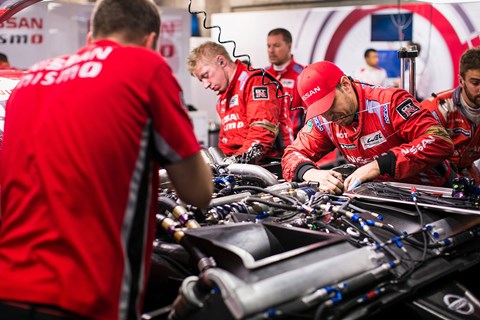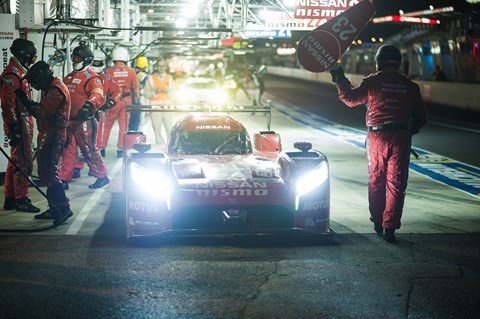► Nissan at Le Mans: doomed or inspired?
► CJ Hubbard blogs on the GT-R LM Nismo
► Race failure, but learning success
Fair to say, the 2015 Le Mans 24 Hours didn’t quite go as well as Nissan had hoped. Only one of the three Nissan GT-R LM Nismo machines entered in the topflight LMP1 category crossed the finishing line, and even that car – number 22, driven by Brits Alex Buncombe and Harry Tincknell plus long-standing Nissan Super GT legend Michael Krumm – was discounted from the results because it failed to complete 70% of the winning Porsche’s 395 laps.
But this is not the same as saying the whole enterprise was a failure. We spent quite a bit of time with the Nissan team over the weekend, including inside the pit garage, and to say that its Le Mans was a test of endurance and fortitude is an understatement.
Click here to read why Nissan went radical at Le Mans.
So what happened – and why?
The first thing to understand is just how radical the Nissan GT-R LM Nismo really is. This is a front-engined, primarily front-wheel drive racing car, with a flywheel hybrid system aimed at the super-skinny rear wheels, and a packaging design fearsomely optimised for the low-drag, high-speed environment of Le Mans. It doesn’t have LM in the title by accident – this is the race Nissan wants to win. The rest of the WEC (World Endurance Championship) is somewhat supplementary, though a high-downforce aero is part of the program.
So while the rest of the manufacturer-backed LMP1 field has chosen a variety of drivetrain and hybrid solutions, they are all a fundamentally conventional mid-engined design. This means that there is a well-established general data set that can largely be found to apply to them. Whereas everything Nissan is doing is fundamentally new; there have been front-engined Le Mans racers in the not-so-distant past (Panoz kept at it until 2003), but no-one has ever attempted to take on the big guns by biasing the front wheels before. Nissan has to build up its data set totally from scratch. The programme only began 14 months ago, the car didn’t turn a wheel until November 2014, and Le Mans 2015 was its first competitive event. This is a very new, very novel concept.

Why put itself through the pain? Well, arch-genius Ben Bowlby apparently has an obsession with unconventional aerodynamic solutions – he was also responsible for the bonkers Nissan Deltawing, after all – and placing the engine in the front allows for a spectacularly efficient ‘aero tunnel’ design (the engine was built to fit the available space, he says), aided by rear tyres that can be made more slender because they aren’t dealing with most of the power. If you want to know more, Nissan has produced a whole bunch of ‘Nismo University’ videos explaining the thinking behind the car, and you can find them on YouTube.
Think different: the Nissan way
The other vital element to this, though, is that Nissan has set out to be deliberately different. It speaks of not just being innovative but ‘disruptive’, and is using the whole shebang as a means of engaging not just with racing fans but with as many people as it can possibly reach. Nissan speaks with direct concern about the digital generation’s lack of engagement with cars and the car industry, and sees innovative approaches such as this one as a direct means of snagging their interest. We did ask if being innovative was more important than victory, though, and were told in no uncertain terms that winning at Le Mans was still the clear target – albeit abundantly obvious that it wouldn’t be happening this year.
As such, unfortunately we can’t help wondering if the rest of the field at Le Mans 2015 didn’t find it disruptive in a different way – which is to say the GT-R LM really wasn’t working very well at all. New cars retiring? That’s just racing (see Porsche last year). But being 20sec off the pace of the class seems like a disaster. Until you learn that the hybrid system intended to deliver in the region of half the car’s quoted 1250bhp wasn’t actually working at all.
Reliability woes aplenty
Reliability issues in initial testing saw the team take the brave decision to turn up at Le Mans without it, in order to go on gathering as much of that necessary new data as possible. The knock-on effect of this is far greater than simply halving the output. Without the balancing effect of electric drive on the rear axles, putting the power down was a nightmare for the drivers – ‘epic torquesteer’ would be another understatement – hence clearly being slower than even the LMP2 class and some of the GT cars on the exit of corners. This improved as the race progressed, however, as the team finessed the traction control settings, and didn’t stop the car reaching 210mph on the Mulsanne.

There’s more. Nissan plans to use a flywheel hybrid system, and part of the GT-R LM’s design relies on the flywheels’ energy harvesting process to provide up to 2g of braking performance. 2g! Without this, stopping the car became an instant major problem. A bigger brake package was hastily assembled – but cooling this without ruining that all-important aero was a nut that just couldn’t be cracked. As soon as the car had to slow for any reason, the brakes caught fire. The first disc change took place within the first six hours (the ones that came off promptly melted a hole in the floor), and this became a depressingly routine process throughout the event.
Other issues included an engine change complication on the Friday night that meant the mechanics ended up doing a 48-hour endurance race, gearboxes that became overly fond of fourth gear, Tincknell’s rather unexpected encounter with debris at somewhere in excess of 200mph in the middle of the night, and what to do about the drop in tyre pressures when running behind the safety car at 4 o’clock in the morning. All of which may have resulted in a total team DNF, but means Nissan has collected a hell of a lot of race-condition data that it would never otherwise have gained.
Will the GT-R LM Nismo ever work as the concept suggests?
Goodness only knows – but we look forward to seeing Nissan with a fully hybrid functional car at Le Mans next year to find out.